Kinematic viscosity is one of the important characteristics of petroleum products such as fuel and lubricants. It is measured by determining the time during which the sample passes through the capillary glass tube viscometer at a certain temperature. Kinematic viscosity is sensitive to temperature changes; therefore, a test cell is needed in order to control and stabilize the temperature. In petroleum products, the temperature stability is one of the most important physical indicators to determine the qualitative and technical properties of the products. In this measurement, the viscosity value of temperature changes can affect and determine the physical and chemical properties of the product. The kinematic viscosity determines the oil's ability to create and maintain lubrication layers between moving parts. The poor performance of the lubricant due to improper viscosity causes wear and overheating. By determining the kinematic viscosity at two temperatures, the viscosity index can also be obtained. The viscosity index is the relationship between the temperature of viscosity changes with the temperature for a petroleum product.
Technical Characteristics
- The temperature range is from Room Temperature to 110 degrees Celsius
- Adjustable light intensity of the test cell for the appropriate test conditions
- Includes 2 test cells for simultaneous testing
- Digital display with ±0.1 accuracy (instrument sensitivity ±0.05 based on ASTM D445 standard)
Temperature Controller
- The microprocessor and temperature controller with the PID mechanism in this series is specifically programmable so that the temperature stability and exact uniformity required to determine the kinematic viscosity and proper accuracy along with calibration can be easily achieved.
- The display shows the temperature of the test cells and the set point.


